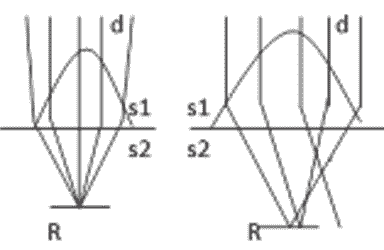Acceptance angle
Acceptance angle can refer to Half of the angular aperture of an optical system Acceptance angle, the angle in an optical fiber below which rays are guided rays Acceptance angle.
The acceptance angle of an optical fiber is defined based on a purely geometrical consideration (ray optics):
it is the maximum angle of a ray hitting the fiber core which allows the incident light to be guided by the core.
Optical telecommunication is usually conducted with infrared light in the wavelength ranges of 0.8–0.9 μm or 1.3–1.6 μm—wavelengths that are efficiently generated by light-emitting diodes or semiconductor lasers and that suffer least attenuation in glass fibres.
Fibrescope inspection in endoscopy or industry is conducted in the visible wavelengths, one bundle of fibres being used to illuminate the examined area with light and another bundle serving as an elongated lens for transmitting the image to the human eye or a video camera.
TIR is sin(i) >= n2/n1,
where
i is angle of incidence in the core,
n2= refractive index of the cladding and
n1=refractive index of the core.
sin(i(c)) = n2/n1,
where
i(c) is the critical angle.
The maximum angle within which Light will be accepted by an element, such as a Detector or waveguide.
In the latter, it is quantified as half the Vertex Angle of the cone within which Optical Power may be coupled into bound Modes of a fiber.
Also called acceptance cone.
Acceptance angle in optical fiber communication is the maximum angle with the axis of the Optical Fiber at which the light can enter into the optical fiber in order to be propagated through it.
The Numerical aperture is considered as a light gathering capacity of optical fibre and defined as the Sine of half of the angle of fibre's light acceptance cone. for example:
NA= Sin θa
where
θa is called acceptance cone angle.
The increase in numerical apertures can be obtained by increasing the imaging medium refractive index (n) between the specimen and the objective front lens

